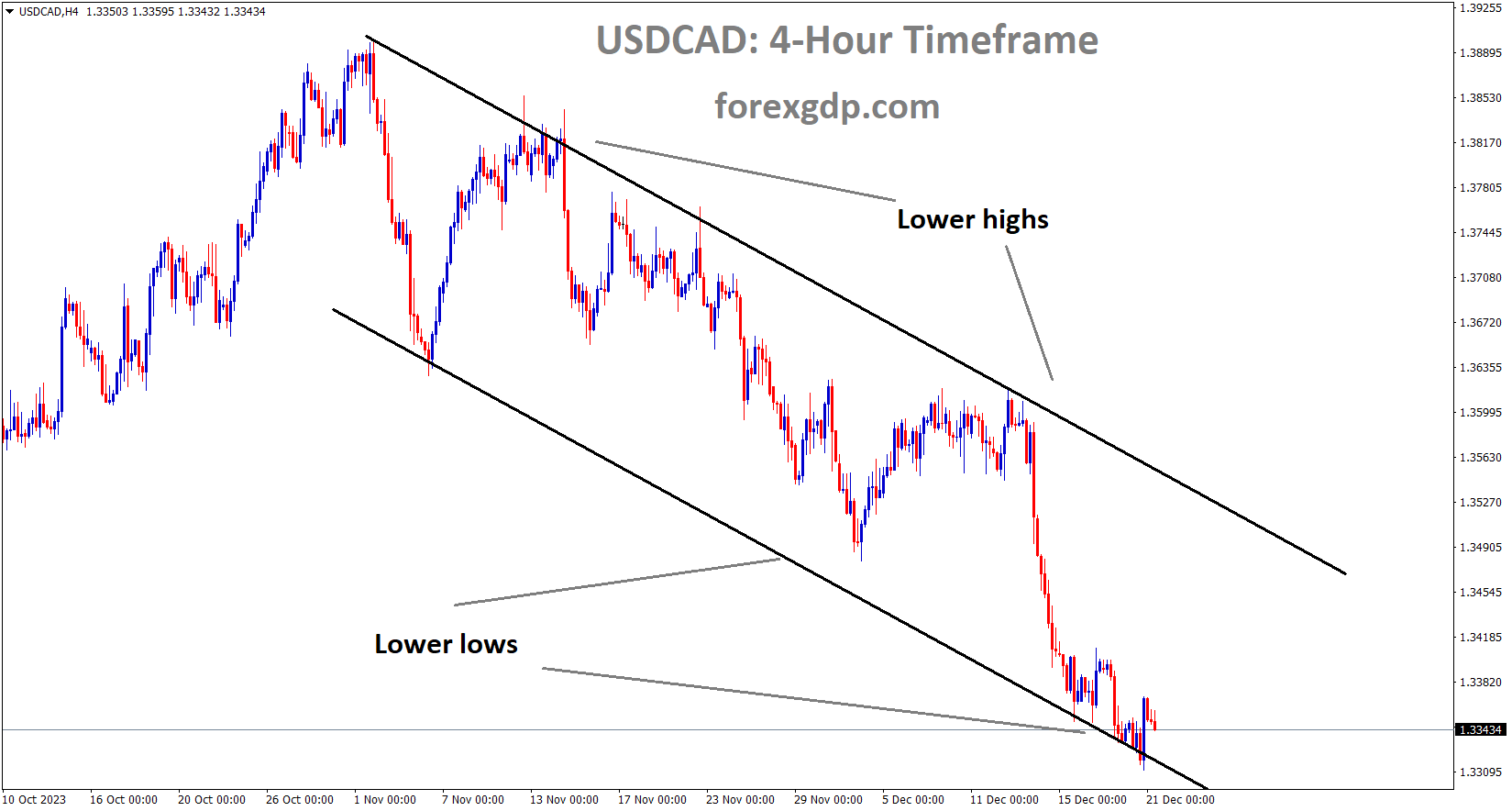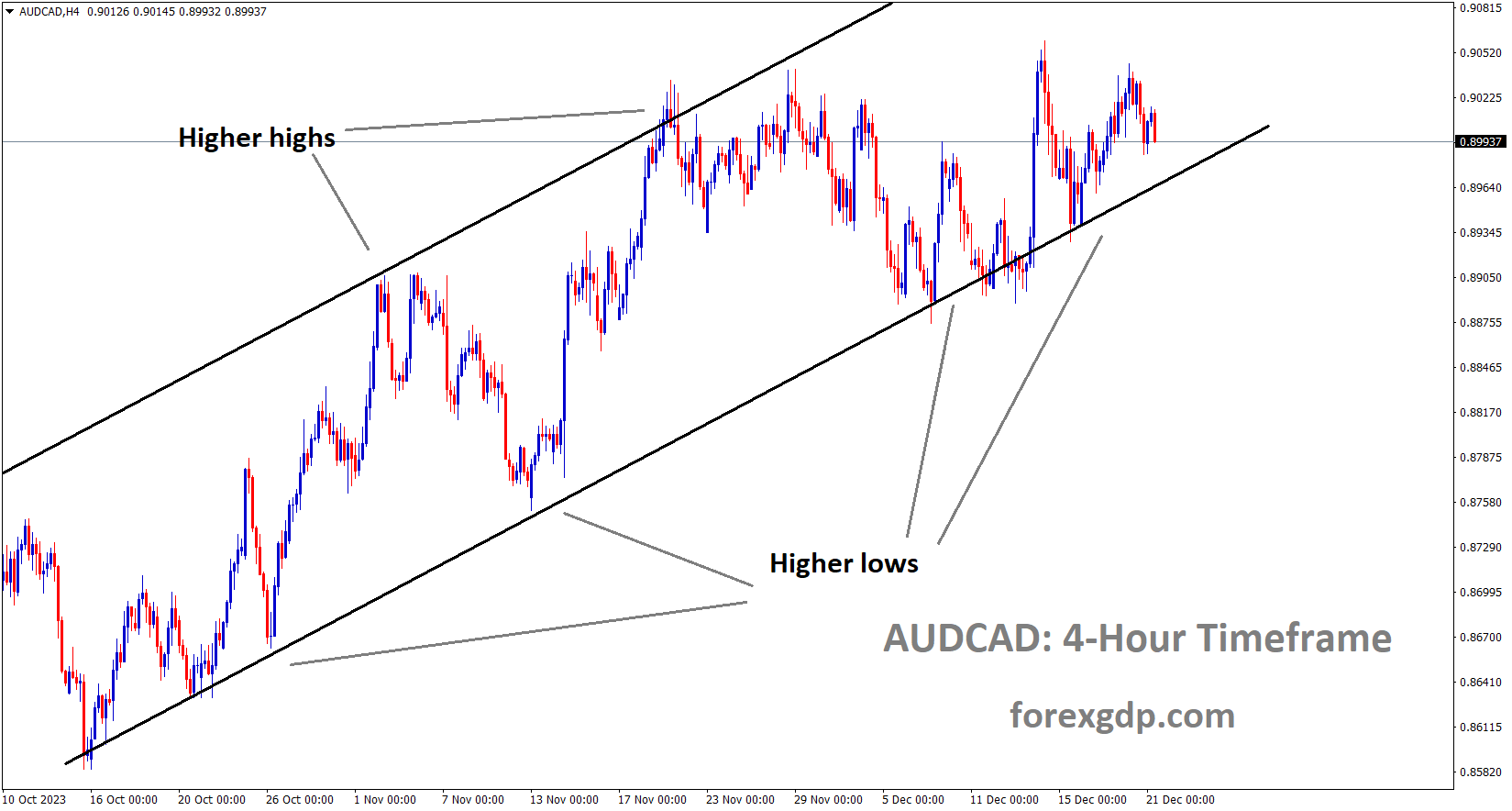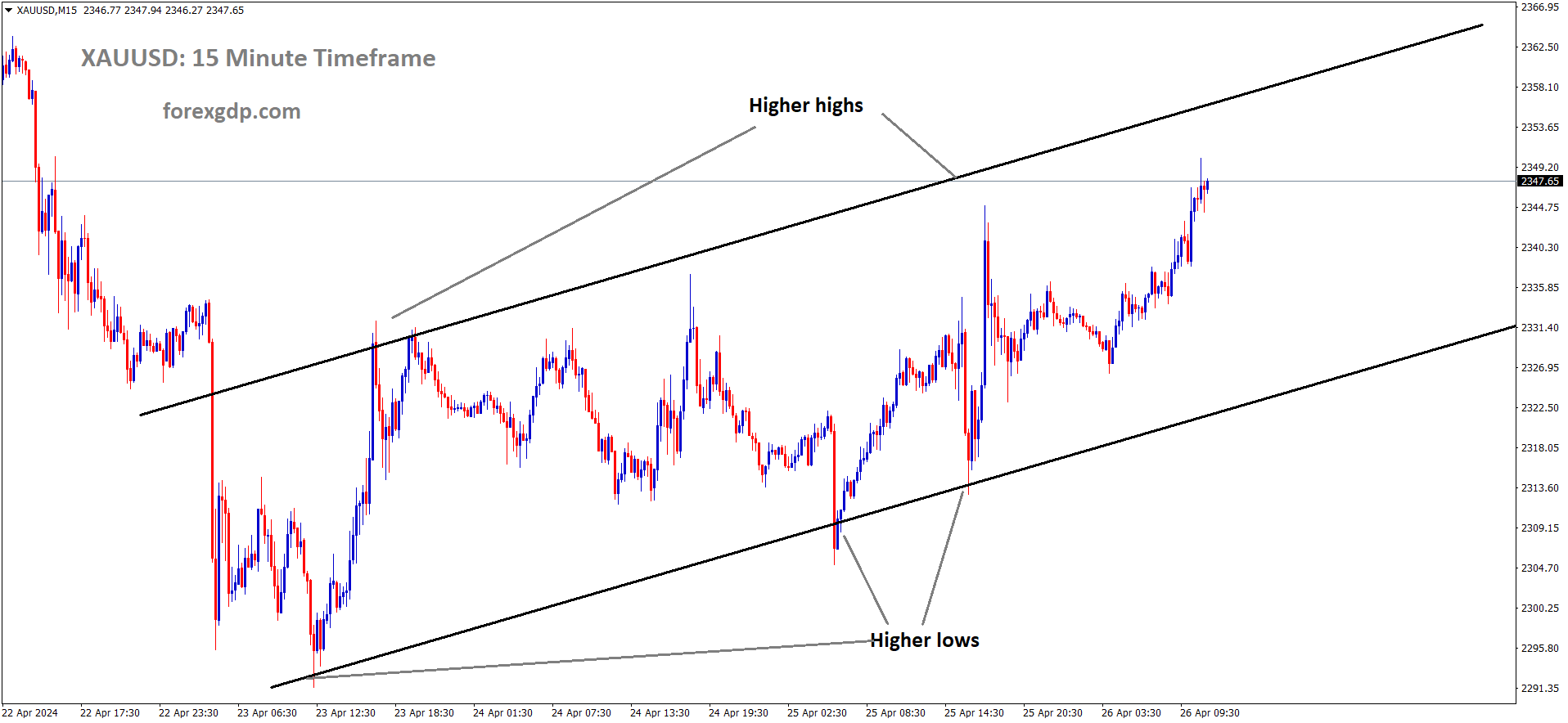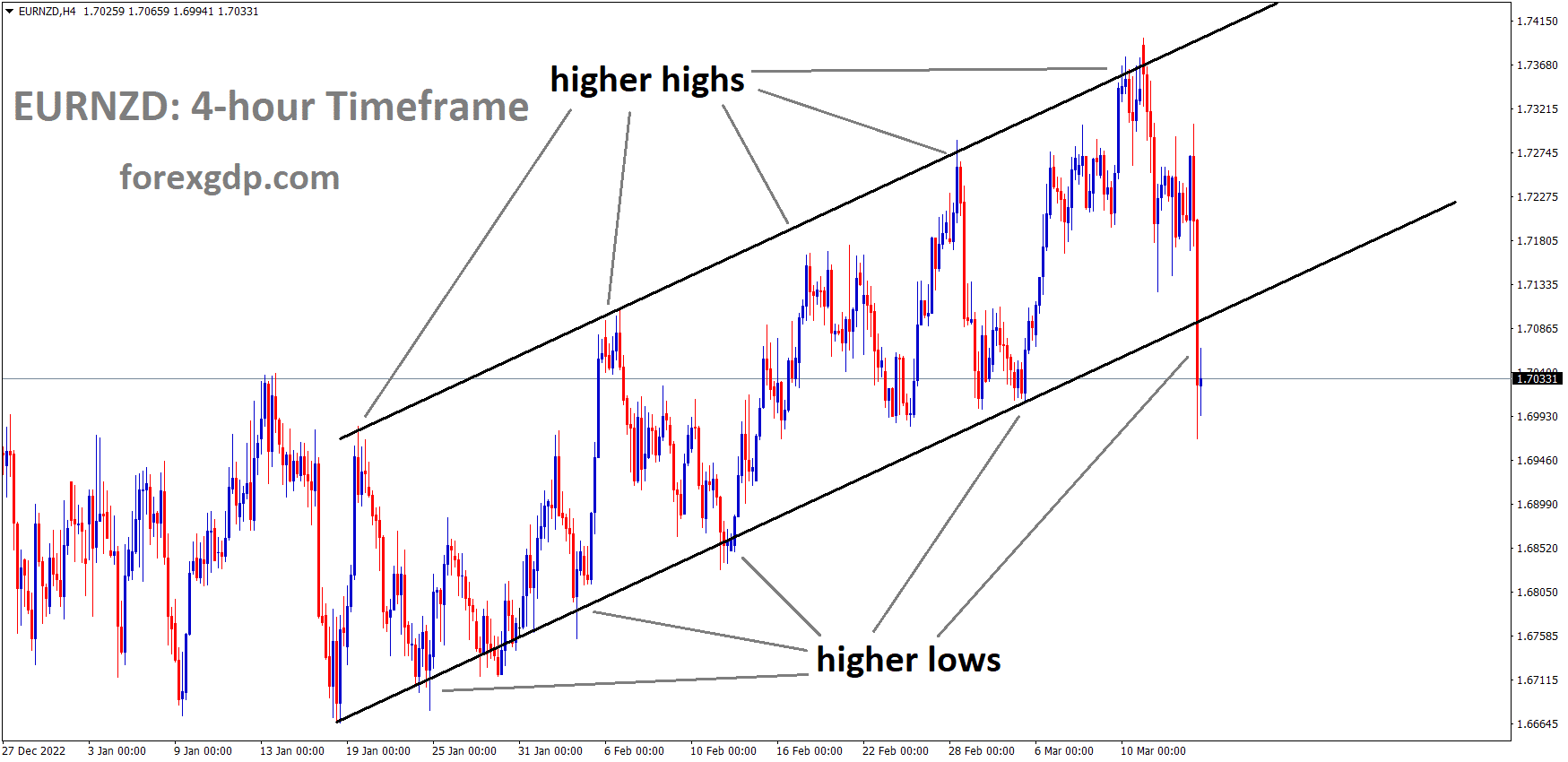USDCAD Analysis:
USDCAD is moving in the Descending channel and the market has reached the lower low area of the channel
The surge in oil prices is benefiting the Canadian Dollar against other currencies. Anticipated Canadian retail sales for November are expected to increase to 0.80%, showing improvement from the 0.60% recorded in October.
The upside potential of the US Dollar appears to be constrained as market participants anticipate three impending rate cuts from the Federal Reserve. Investors are eagerly awaiting the release of Canadian Retail Sales and US GDP growth figures on Thursday, events that could potentially inject volatility into the currency pair ahead of the upcoming holiday season.

The hawkish comments made by the Federal Reserve last week, coupled with the signal that the central bank intends to implement a total of 75 basis points in interest rate cuts, have placed some downward pressure on the US Dollar across the board. Although Fed Chair Jerome Powell did not provide specific guidance regarding the timing of these rate cuts, the market is bracing for a possible cut as early as March.
AUDCAD Analysis:
AUDCAD is moving in an Ascending channel and the market has reached the higher high area of the channel
On Wednesday, there was a notable uptick in US CB Consumer Confidence for December, marking the most significant increase since early 2021, with a reading of 110.7 compared to the previous figure of 101.0. Additionally, the annual rate of Existing Home Sales in November surpassed expectations, reaching 3.82 million, outperforming the market consensus of 3.77 million.

Turning to the Canadian Dollar, the Bank of Canada disclosed the Summary of Deliberations from its December 6 meeting. The Governing Council concluded that interest rates were sufficiently high to counteract inflation, leading them to maintain the status quo on borrowing costs at the December meeting. However, the central bank acknowledged that inflation-related risks remained elevated, leaving the door open for potential future rate hikes. Traders will be closely monitoring the Canadian Retail Sales data for October, which is expected to reveal a 0.8% month-on-month increase, up from the 0.6% recorded in the previous reading. Additionally, the release of US Gross Domestic Product Annualized data for the third quarter is scheduled for Thursday, with the growth rate anticipated to remain steady at 5.2%.
GOLD Analysis:
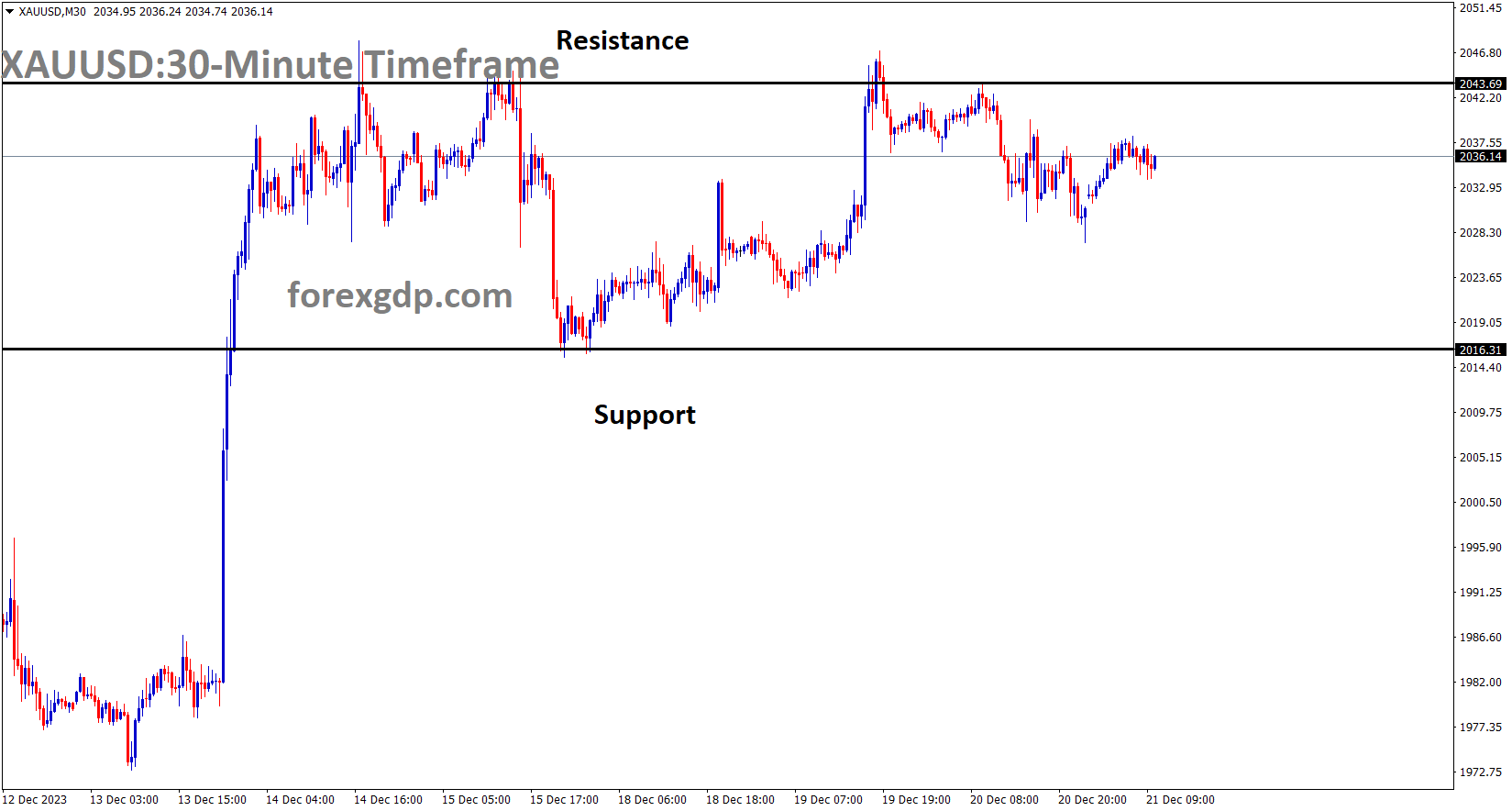
XAUUSD Gold price is moving in the Box pattern and the market has fallen from the resistance area of the pattern
Gold prices are maintaining their strength and showing a bullish trend against the USD. Meanwhile, heightened tensions in the Red Sea region, caused by disturbances from Hamas affecting commercial vessels, have the potential to drive up Gold prices further. If no proactive measures are taken to address this issue, the fear of escalating conflicts in the market could lead to an increase in Gold prices.
Gold prices regained their strength during the US session, surging above the $2040 per ounce resistance level. While a slightly stronger US Dollar initially subdued Gold bulls during the European session, ongoing remarks from Fed officials discussing potential rate cuts continued to put pressure on the Greenback. The focal point of the week has been the escalation of geopolitical tensions in the Middle East, particularly in the Red Sea region, contributing to an atmosphere of uncertainty that appears poised to intensify. In light of these developments, Gold remains in a dominant position, with the potential for further gains if the Middle East strife and tension persist without a resolution.

The resurgence of weakness in the US Dollar has also provided support for Gold, allowing it to maintain its upward momentum. Federal Reserve policymakers have adopted a dovish stance this week, with most emphasizing the necessity for rate cuts in 2024, and there has been limited resistance to this view, aside from occasional comments expressing the need to monitor incoming data. Policymaker Barkin’s dissenting opinion stands out, as he believes that inflation is proving to be more persistent than what the typical Fed official anticipates.
US Treasury Yields continue to struggle, with both the 2-year and 10-year yields facing challenges, which further benefits Gold. Looking ahead, important US economic data is on the horizon, with the release of the US PCE data scheduled for Friday. This data could significantly influence US rate expectations as the year draws to a close. Additionally, the final Q3 GDP figure will be released. There are also other noteworthy US data releases, such as the CB consumer confidence and the final Michigan Consumer Sentiment numbers, which may prompt short-term market movements but are unlikely to have a lasting impact and could potentially be reversed by the end of the trading session.
SILVER Analysis:
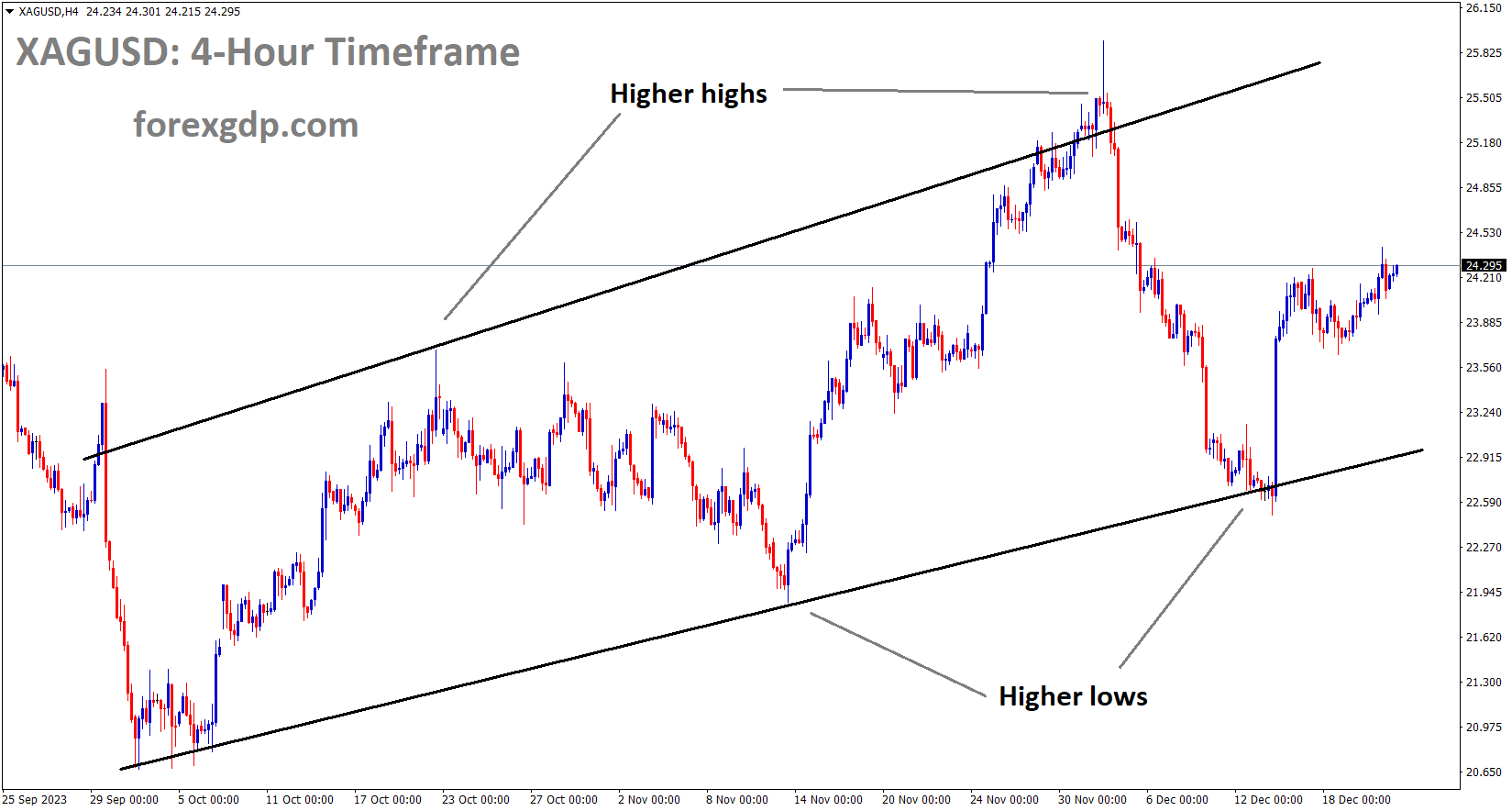
XAGUSD Silver price is moving in an Ascending channel and the market has rebounded from the higher low area of the channel
In December, the US Consumer Sentiment index reached 110.7, surpassing the previous reading of 101.0 in November. Despite this positive data, the US dollar remained weak.

In December, consumer sentiment in the United States showed improvement, as indicated by the Conference Board’s Consumer Confidence Index, which increased from 101.0 in November to 110.7. A closer look at the report revealed that the Present Situation Index climbed from 136.5 to 148.5, while the Consumer Expectations Index also saw gains, rising from 77.4 to 85.6. Notably, the one-year consumer inflation rate expectation slightly decreased to 5.6%.
USDCHF Analysis:
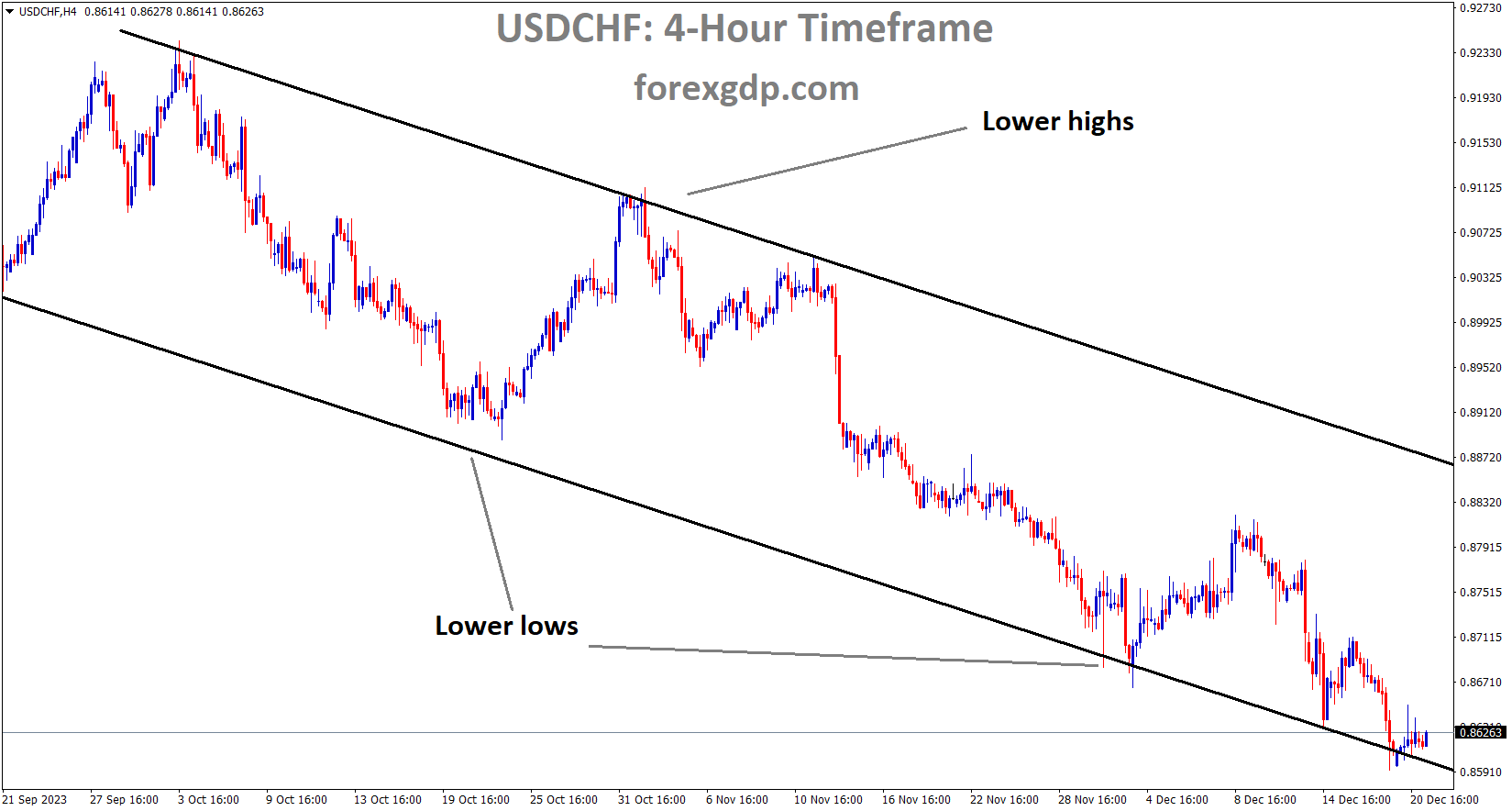
USDCHF is moving in the Descending channel and the market has reached the lower low area of the channel
Today, the UK and Switzerland are convening a meeting to discuss financial system transactions involving Swiss banks. This discussion holds the potential to benefit both corporations and banks based in London.
On Thursday, the UK and Switzerland are set to formalize a closer relationship through a post-Brexit agreement, aimed at strengthening the connection between London’s financial hub and the Swiss banking system. This mutual recognition agreement will be signed during Chancellor Jeremy Hunt’s visit to Berne, marking a significant step in aligning Europe’s largest financial centers. The UK Treasury asserts that this partnership will provide a post-Brexit boost for the UK, facilitating cross-border market access for a wide range of financial services offered by insurers, banks, and asset managers. Chancellor Hunt will emphasize that this agreement became possible once the UK exited the EU, enabling it to negotiate its own agreements with major financial hubs. The Berne Financial Services Agreement builds upon the already thriving financial services relationship between the UK and Switzerland. The Treasury anticipates that this deal will simplify business transactions for large corporations and affluent individuals in both countries. London, renowned for its extensive financial activities, has previously established an agreement with New York, the world’s largest financial center.

Nonetheless, a recent study by the City of London Corporation revealed that other financial centers are outpacing London’s growth, ranking it second to its US counterpart. Cities such as Singapore, Paris, and Frankfurt were identified as gaining ground at London’s expense. Switzerland has also seen its financial reputation tarnished following the collapse of its second-largest bank, Credit Suisse, necessitating a rescue through a merger with its rival UBS earlier this year. Trade expert David Henig, UK director at the European Centre for International Political Economy, noted that assessing the impact of the agreement is challenging without specific details. He suggested that it might go beyond the equivalence agreement the EU has with Switzerland but emphasized the need for more information to make a comprehensive judgment.
This agreement is expected to benefit companies like Lloyd’s of London and other insurers that have faced regulatory obstacles when structuring complex deals. The UK government has portrayed the signing of new trade deals as one of the advantages of Brexit. Earlier this year, the UK entered into an agreement to join an 11-nation Asia-Pacific free-trade bloc, which includes countries such as Australia, Singapore, Japan, and Canada. Labour MP Paul Blomfield, co-convener of the cross-party UK Trade and Business Commission, welcomed the agreement as a positive step toward providing regulatory certainty for UK industries and their vital markets. However, he urged the government to go further and engage in talks with Brussels, emphasizing the importance of maintaining beneficial regulatory alignment with the EU, which remains the largest overseas market for most British businesses.
GBPUSD Analysis:
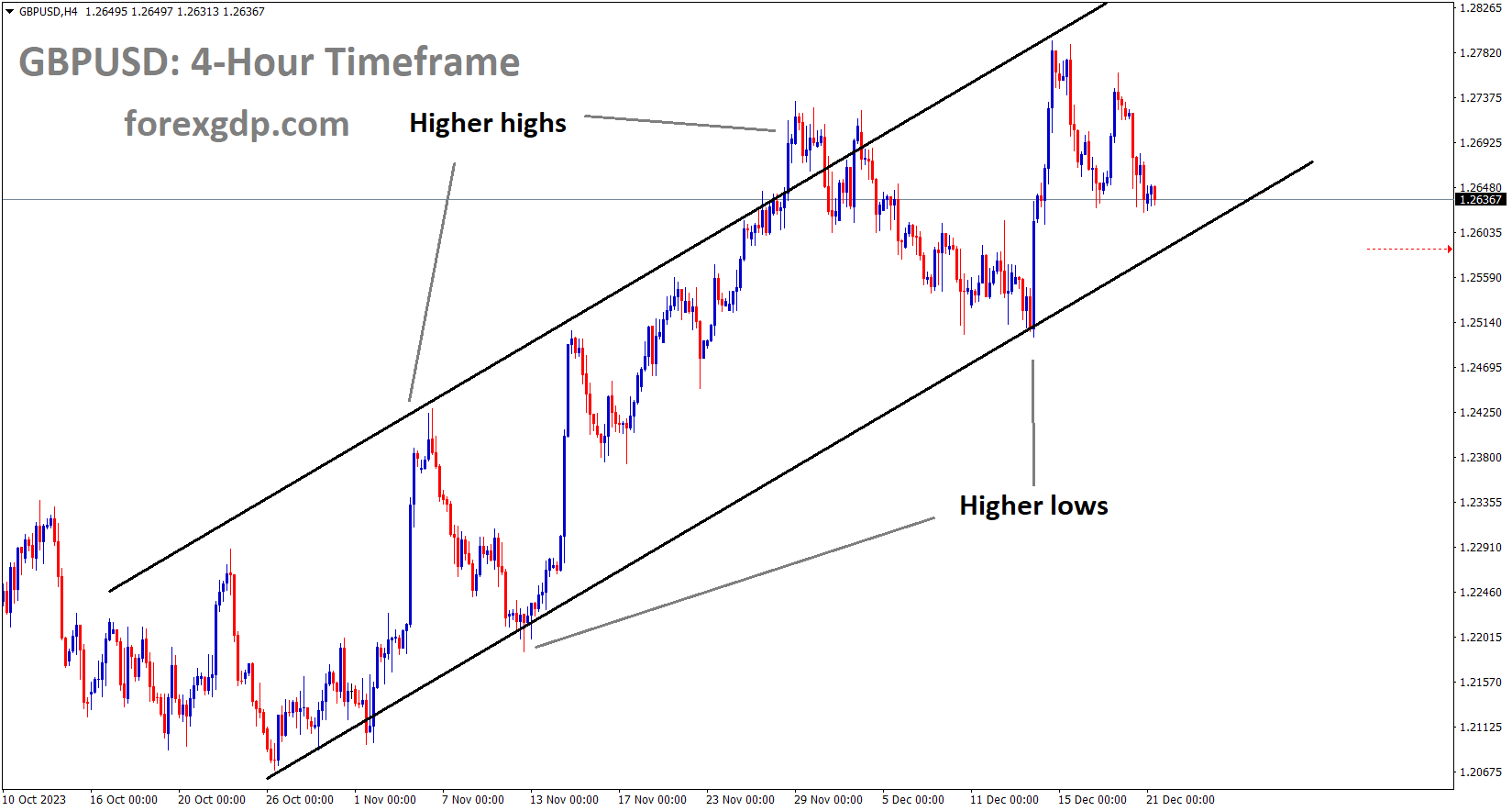
GBPUSD is moving in an Ascending channel and the market has reached the higher low area of the channel
In November, UK inflation retreated to the September 2021 level of 3.9%, marking a significant decline from the double-digit growth seen in 2022. The British Pound (GBP) experienced a drop in value due to concerns over potential interest rate cuts by the Bank of England in their upcoming meeting.
Market participants are currently wrestling with the prospect of interest rate reductions, and they are now confronted with the added uncertainty of increasing geopolitical tensions. The UK inflation figures released today have further fueled speculation of potential rate cuts, as the data fell significantly below expectations. This development is likely to bring relief to both UK consumers and the Bank of England, given that market expectations are already factoring in the possibility of rate cuts as early as May. In the backdrop of escalating geopolitical tensions in the Middle East, Gold and Oil have emerged as the primary beneficiaries this week. Both of these commodities are expected to maintain their positive trajectory in the short term, as concerns over supply disruptions are anticipated to worsen with the prolonged conflict in Israel. Looking ahead, market attention will shift to the release of US PCE data at the end of the week.
EURJPY Analysis:
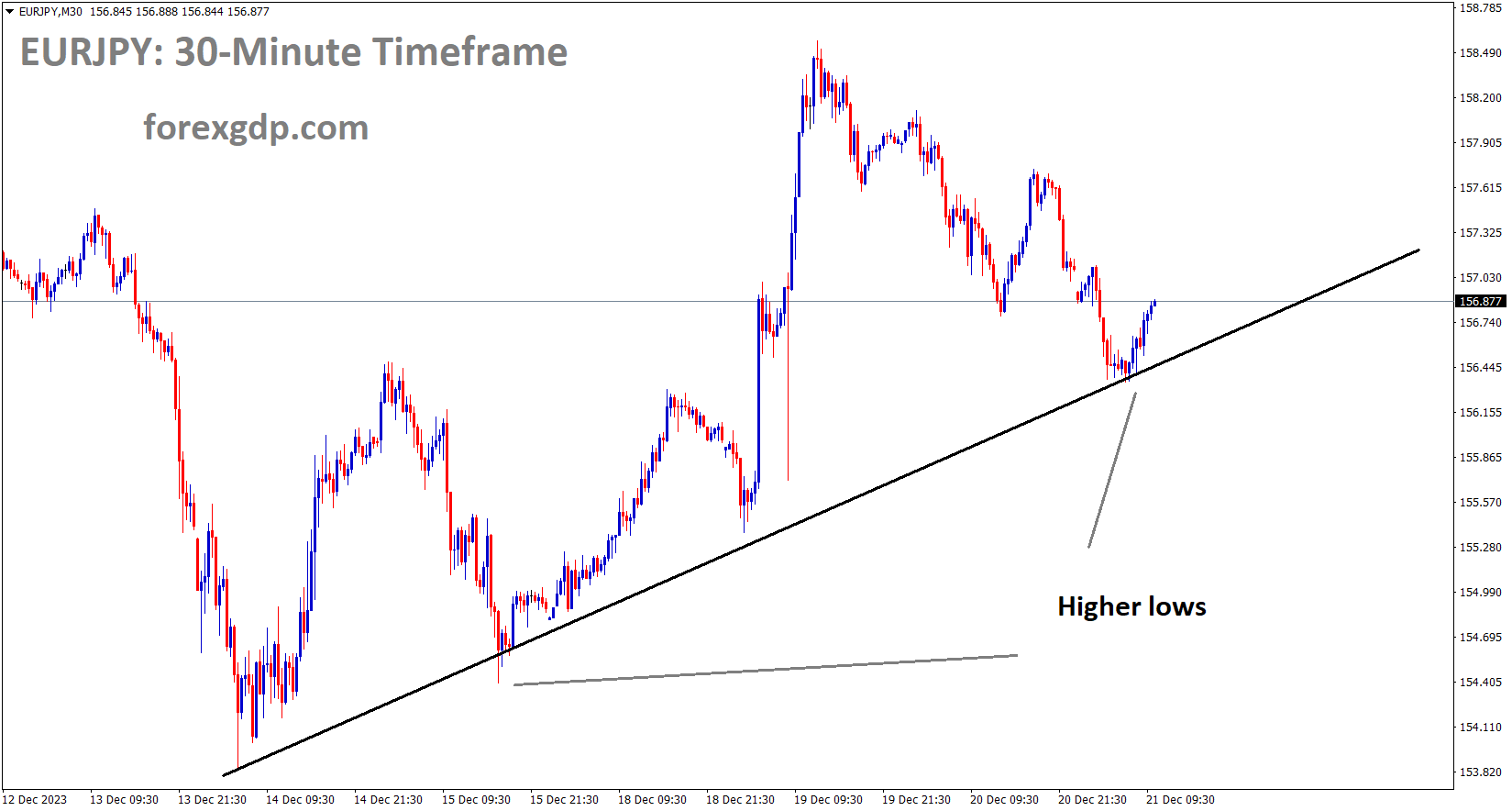
EURJPY is moving in an Uptrend line and the market has rebounded from the higher low area of the trend line
The Bank of Japan’s decision to keep rates unchanged in the short term was met with disappointment in the market, causing the Yen to weaken against its counterpart currencies. Economists anticipate the possibility of rate hikes from the Bank of Japan in the first half of 2024.
The Japan Cabinet has unveiled the economic forecasts for FY2023-2024 and FY2024-2025, showing a slight improvement compared to six months ago. For FY 2023-2024, the forecast has increased to 1.6% from the previous 1.3%. Meanwhile, for FY 2024-2025, the forecast now stands at 1.3%, up from the previous 1.2%. Inflation is projected to reach 2.5% in the upcoming fiscal year.
The recent decision by the Bank of Japan disappointed market expectations, as they chose to maintain their existing monetary policy rather than implementing the changes that many had anticipated. This decision resulted in a weakening of the Japanese yen and a 1.4% increase in the Nikkei stock index. Meanwhile, members of the Federal Reserve in the US have made efforts to counter expectations of future interest rate cuts. However, despite these efforts, the market still anticipates a series of rate cuts starting in March 2022. Consequently, the US dollar remains weak, with the US dollar index consistently hovering at low levels. Furthermore, US Treasury yields have also declined to their lowest levels in weeks.

These conditions are expected to favor gold, as the anticipation of future rate cuts typically boosts its value. Nevertheless, despite these expectations, gold’s performance has been relatively modest. It is currently trading around $2028, with resistance levels at $2032 and $2043. Despite potential sell-offs, there is anticipated interest from buyers in gold, and the prevailing trend in the coming weeks is projected to be an increase in its value. In terms of stock indices, the S&P 500, NASDAQ 100, and Dow Jones have all achieved new record highs. However, trading ranges have been relatively narrow due to reduced market activity during the holiday season. Towards the end of the week, there may be some profit-taking, particularly if the US inflation figure exceeds expectations.
In the currency market, the Japanese yen has been a significant player, weakening against other currencies following the BOJ’s decision. Other currencies, such as the Canadian dollar, euro, and sterling, have also experienced some fluctuations. Overall, as the festive break approaches, the market is winding down and becoming less active. The US dollar is exhibiting limited movement, stock indices are relatively stable, and gold is consolidating. The upcoming release of the Core PCE data on Friday is expected to bring a final burst of volatility before the market enters a week and a half of reduced activity.
On Thursday, the Japanese Cabinet Office revised its economic growth forecasts for the current fiscal year, indicating that robust external demand is expected to compensate for sluggish domestic consumption. The revised estimate for real economic growth in fiscal year 2023/24 now stands at 1.6%, up from the 1.3% projection made six months ago. Additionally, the economic growth projection for fiscal year 2024/25 has been raised to 1.3%, slightly exceeding the previous estimate of 1.2%. This shift is primarily attributed to the anticipation that external demand will more than offset the weakness in domestic consumption.
The outlook for domestic demand is anticipated to improve in the upcoming fiscal year, buoyed by planned income tax reductions in addition to the ongoing trend of wage increases. Furthermore, inflation is projected to decelerate to 2.5% for the next fiscal year.
EURNZD Analysis:
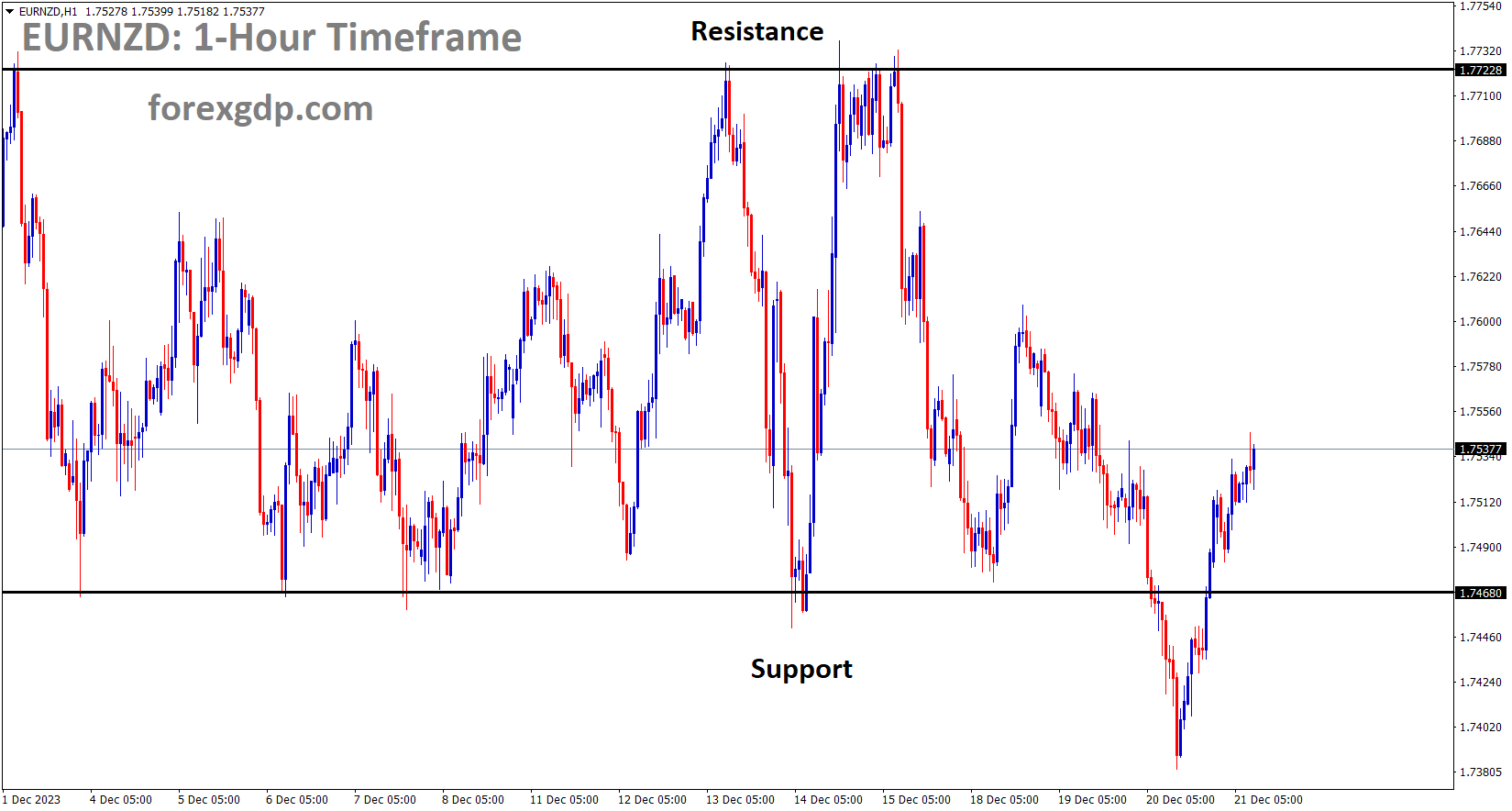
EURNZD is moving in the Box pattern and the market has rebounded from the support area of the pattern
ECB Governing Council member Martins Kazaks has indicated that rate cuts from the ECB are anticipated starting in 2024.
Late on Wednesday, Martins Kazaks, a member of the European Central Bank’s Governing Council, emphasized the need to maintain the current interest rates for an extended period. However, it appears that the initial rate reduction may occur later than what investors are currently anticipating, which is around the middle of 2024. It is more likely to take place in June or July of the following year. However, as of the present moment, implementing rate cuts in the spring is deemed premature. The timing and pace of these rate cuts will be contingent on the actual performance of the economy and the unfolding economic developments.
AUDCHF Analysis:
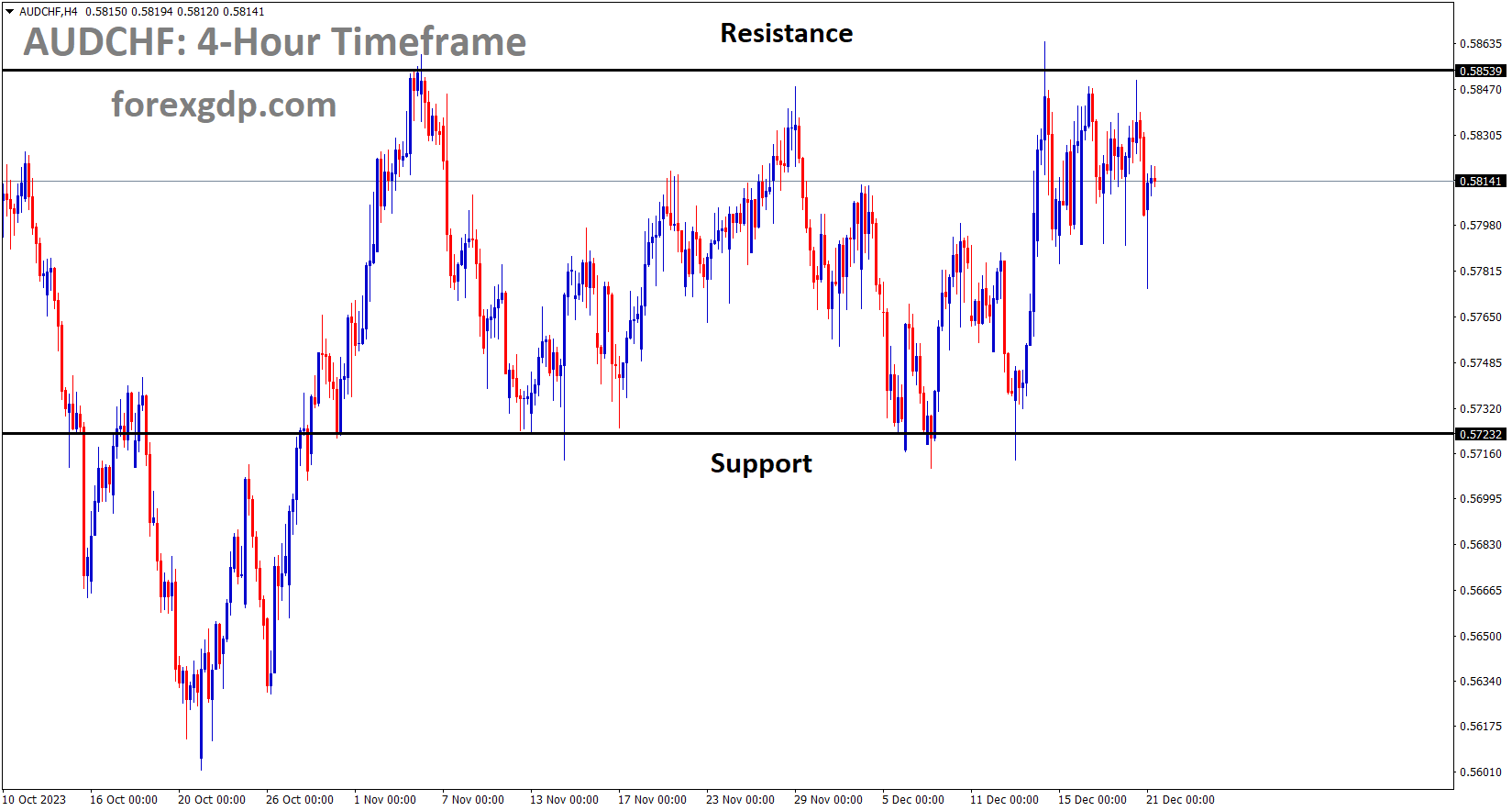
AUDCHF is moving in the Box pattern and the market has fallen from the resistance area of the pattern
The possibility of RBA considering rate hikes hinges on incoming data that could drive the Australian Dollar higher against other currencies. Furthermore, China’s decision to maintain unchanged LPR rates yesterday provides support for Australian exports to China.
In the previous trading session, the US Dollar strengthened against the Australian Dollar, driven by improved economic data from the United States. As a result, the AUDUSD pair ended a five-day winning streak. The Reserve Bank of Australia took a hawkish stance, as evidenced in the Meeting Minutes released on Tuesday, providing support for the Australian Dollar. The central bank is expected to closely analyze additional data to assess the risk balance before making future interest rate decisions. According to the World Interest Rate Probability Tool, there is a widespread expectation that the RBA will refrain from cutting rates in its February policy meeting.
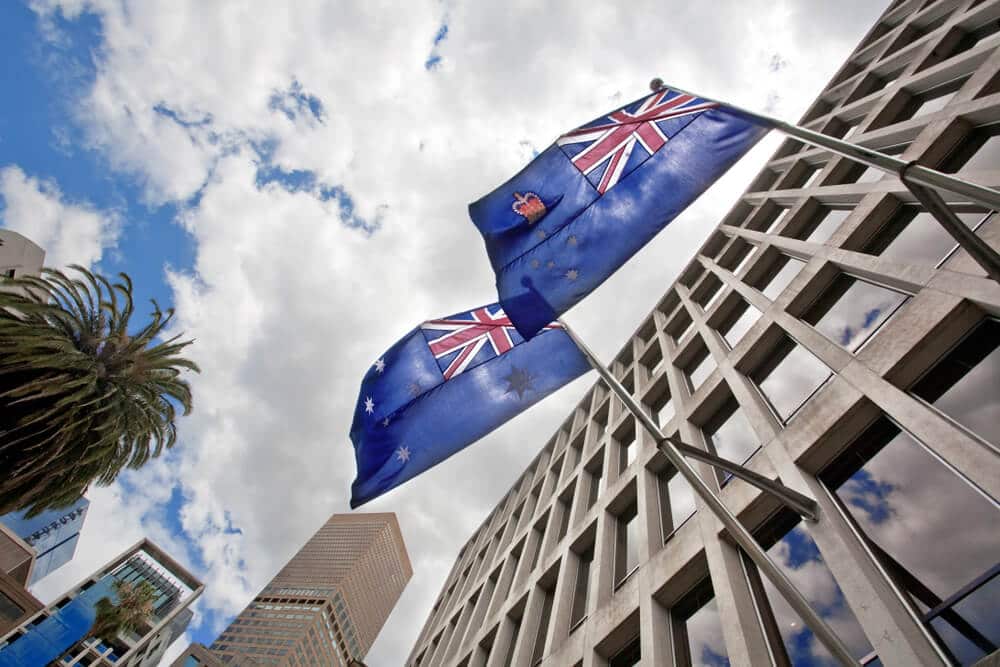
Despite improved US Treasury yields, the US Dollar Index faced downward pressure on Thursday. This was partly due to the dovish sentiment surrounding the US Federal Reserve’s interest rate outlook for early 2024. However, Fed officials cautioned against premature speculations and advocated for a cautious approach. In economic news, US Existing Home Sales Change rebounded with a 0.8% monthly increase in November, reversing the previous month’s 4.1% decline. CB Consumer Confidence also saw substantial growth in December, marking the most significant increase since early 2021, rising from 101.0 to 110.07.
Looking ahead, market participants will be closely watching the release of US Gross Domestic Product Annualized, Initial Jobless Claims, and the Philadelphia Fed Manufacturing Survey on Thursday. Australia’s preliminary Judo Bank Composite PMI improved to 47.4 from the previous reading of 46.2, with the Manufacturing PMI registering 47.8, a slight increase from the prior figure of 47.7, and the Services PMI growing to 47.6 compared to the previous reading of 46.0. Australia’s Consumer Inflation Expectations for December eased to 4.5% from the previous figure of 4.9%. The People’s Bank of China maintained its benchmark rate at 3.45% in its Interest Rate Decision released on Wednesday.
Several Fed officials, including New York Fed President John Williams, San Francisco Fed President Mary Daly, and Chicago Fed President Austan Goolsbee, expressed skepticism about the market’s anticipation of a rate cut in March, cautioning that such predictions may be premature. In terms of housing data, US Housing Starts exceeded expectations at 1.56 million, while Building Permits slightly missed forecasts at 1.46 million, just below the expected 1.47 million.
NZDUSD Analysis:
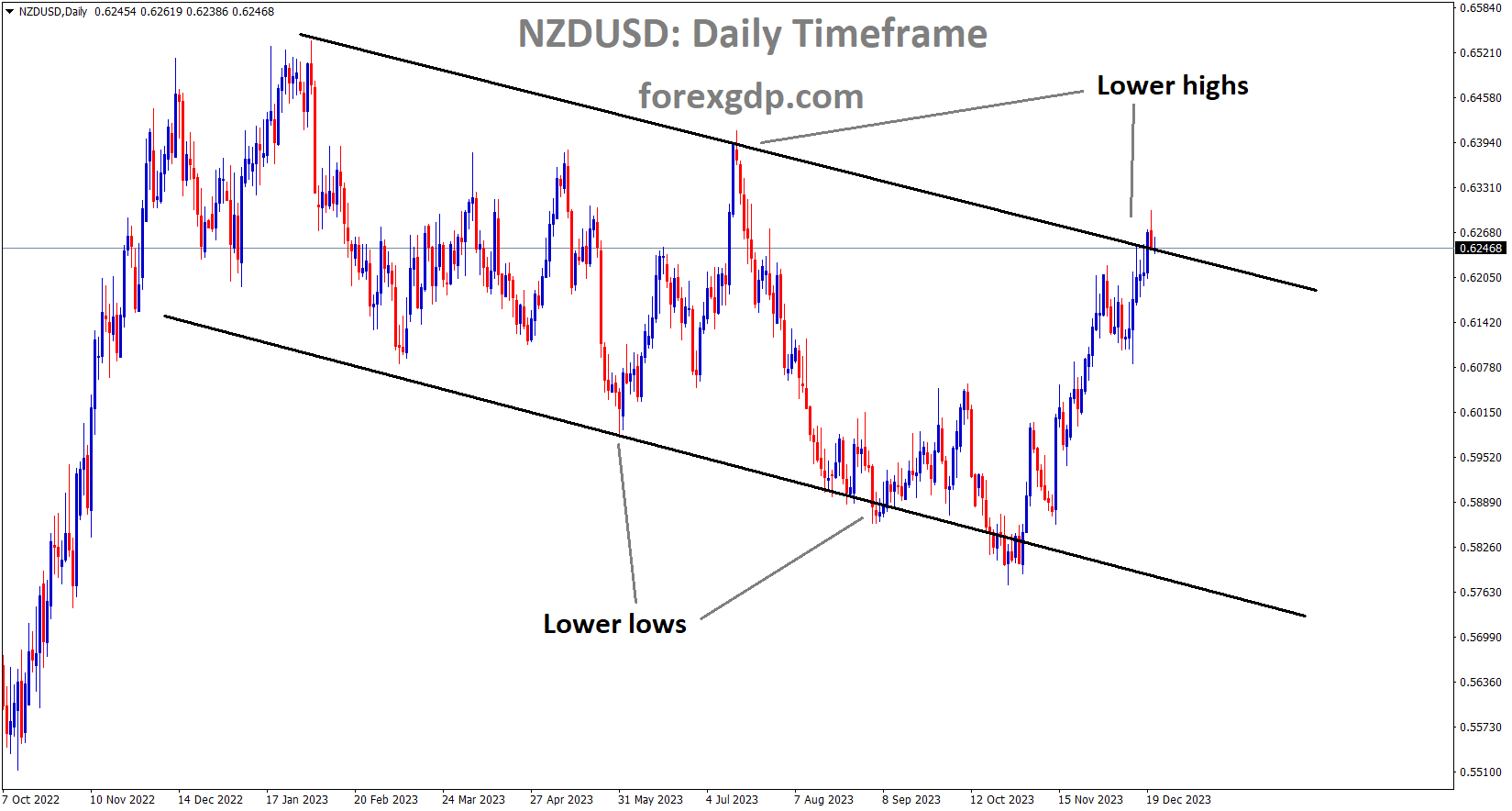
NZDUSD is moving in the Descending channel and the market has reached the lower high area of the channel
The NZD Consumer Confidence data has seen an increase compared to the previous reading, and credit card spending surged by 3.3% in November, a significant improvement from the -2.8% recorded in October. As a result of this robust domestic data, the NZD Dollar strengthened against other currencies.
A resurgence in existing home sales and a substantial surge in consumer confidence are both encouraging indicators for the US economy. In November, the US Existing Home Sales Change demonstrated a significant monthly increase of 0.8%, reversing the previous month’s decline of 4.1%. Meanwhile, CB Consumer Confidence experienced substantial growth in December, surging from 101.0 to 110.07.

The fact that the US Dollar Index has declined despite higher Treasury yields suggests that investors are closely monitoring the Federal Reserve’s stance. It appears that the prevailing dovish sentiment regarding the trajectory of interest rates is impacting market sentiment. Currently, the DXY is trading lower around 102.40, while the yields on US 2-year and 10-year bonds are bidding at 4.38% and 3.88%, respectively.
On the New Zealand Dollar front, improved Consumer Confidence data on Wednesday provided support, bolstering the Kiwi against the US Dollar. Reserve Bank of New Zealand Governor Adrian Orr’s cautious approach and recognition of the challenges ahead, especially in the context of elevated inflation levels, highlight the complexities of navigating economic terrain. Additionally, on Thursday, Kiwi Credit Card Spending revealed a 3.3% increase in November, in contrast to the 2.8% decline seen in October. As for the United States, investors are awaiting the release of key data, including US Gross Domestic Product Annualized, Initial Jobless Claims, and the Philadelphia Fed Manufacturing Survey.
Don’t trade all the time, trade forex only at the confirmed trade setups.
Get more confirmed trade setups here: forexgdp.com/buy/

